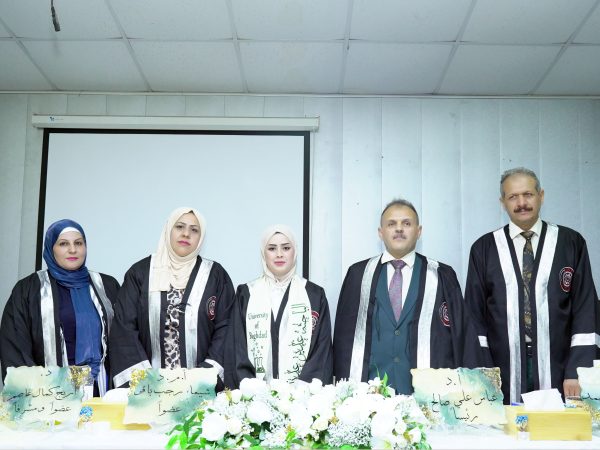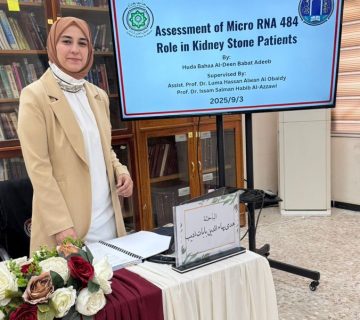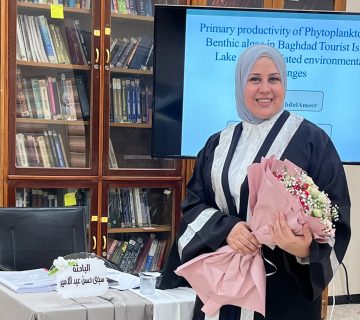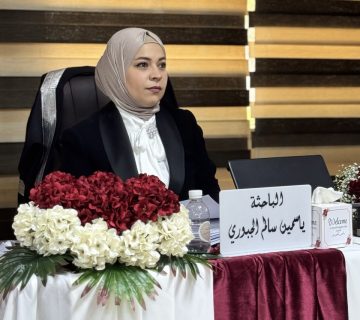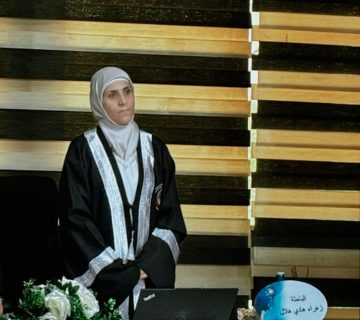The College of Science for Women at the University of Baghdad discussed the master’s thesis tagged (Synthesis, Characterization, and Bioactivity Evaluation of some New Transition Metal Complexes with two Organic Ligands)
Student: Ghadeer Adnan Lizem kazem
The thesis aims to:
- Preparation of two organic nitrogenous ligands and their identification using available spectroscopic methods: (FT-IR, UV-Vis, Mass, TGA & DCS, 1H-NMR, C.H.N).
- Using the prepared ligand to prepare a series of complexes with salts of some metal ions (Cr+3, Mn+2, Fe+2, Co+2, Ni+2, Cu+2, Mo+6, Ru+3, Rh+3, Pd +2, Pt+4) and diagnosing the prepared complexes by means of (infrared radiation, ultraviolet-visible radiation, mass, thermogravimetric decomposition curve, precise element analysis, proton nuclear magnetic resonance, molar conductivity, magnetic susceptibility, chlorine content and metal percentage as well). about the melting point).
- Determine the most stable proposed forms according to diagnostic techniques for the prepared compounds.
- Study of thermal analysis of complexes and decomposition stages through the DSC curve
- Study of the ability of prepared compounds (ligand and its complexes) as antioxidants using gallic acid as a reference and DPPH as a free radical.
- Studying the effectiveness of the prepared compounds as antibacterial agents against bacteria, Staphylococcus aureus, Escherichia Coli, and the fungi Aspergillus Niger.
This study, which was conducted at the University of Baghdad – College of Science for Women – Department of Chemistry – Inorganic Laboratory in Baghdad, Republic of Iraq, for the period from October 2023 until May 2024, Preparation of the formamidine ligand. The ligand was used to prepare a series of complexes for each of the ions (nickel, copper, cobalt, iron, manganese, palladium, divalent chromium, ruthenium, trivalent rhodium, quadrivalent platinum, and hexavalent molybdenum) and diagnose the complexes with techniques (infrared, ultraviolet, visible, mass Thermogravimetric decomposition curve, precise element analysis, proton nuclear magnetic resonance, molar conductivity, magnetic susceptibility, chlorine content and metal percentage, as well as the melting point), and evaluation of the biological activity of both the ligand and the prepared complexes
The most important recommendations reached by the letter are
- New complexes of formamidine ligand (HL) with lanthanide and other transition elements can be prepared..
- Use THF solvent in preparing complexes because it helps the ligand dissolve easily and evaporate quickly, and avoid using DMSO because it is very difficult to evaporate
- Preparation of formamidine ligands replaced by other functional groups
- It is possible to study the biological effectiveness of other types of bacteria and fungi and compare them with some drugs for the possibility of using them in the pharmaceutical field and benefiting from them in the pharmaceutical industry.
5- Study the effect of these compounds in treating cancerous tumors in animals.
